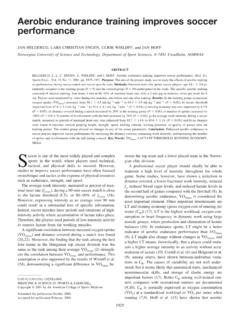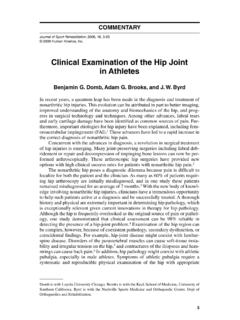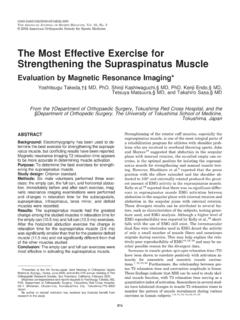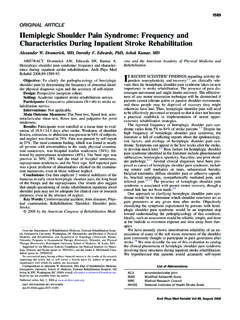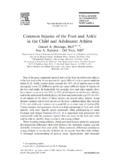Transcription of Aerobic endurance training improves soccer …
1 Aerobicendurancetrainingimprovessoccerpe rformanceJAN HELGERUD, LARS CHRISTIAN ENGEN, ULRIK WISL FF, and JAN HOFFN orwegian University of Science and Technology, Department of Sport Sciences, N-7491 Trondheim, NORWAYABSTRACTHELGERUD, J., L. C. ENGEN, U. WISL FF, and J. HOFF. Aerobic endurance training improves soccer Exerc., Vol. 33, No. 11, 2001, pp. 1925 :The aim of the present study was to study the effects of Aerobic trainingon performance during soccer match and soccer specific :Nineteen male elite junior soccer players, age yr,randomly assigned to the training group (N 9) and the control group (N 10) participated in the study. The specific Aerobic trainingconsisted of interval training , four times 4 min at 90 95% of maximal heart rate, with a 3-min jog in between, twice per week for 8wk. Players were monitored by video during two matches, one before and one after :In the training group: a) maximaloxygen uptake (V O2max) increased from mL kg 1 min 1to mL kg 1 min 1(P ); b) lactate thresholdimproved from mL kg 1 min 1to mL kg 1 min 1(P ); c) running economy was also improved by (P ); d) distance covered during a match increased by 20% in the training group (P ); e) number of sprints increased by100% (P ); f) number of involvements with the ball increased by 24% (P ); g) the average work intensity during a soccermatch, measured as percent of maximal heart rate, was enhanced from to (P ); and h) no changeswere found in maximal vertical jumping height, strength, speed, kicking velocity, kicking precision, or quality of passes after thetraining period.
2 The control group showed no changes in any of the tested :Enhanced Aerobic endurance insoccer players improved soccer performance by increasing the distance covered, enhancing work intensity, and increasing the numberof sprints and involvements with the ball during a Words:V O2max, LACTATE THRESHOLD, RUNNING ECONOMY,SKILLS occer is one of the most widely played and complexsports in the world, where players need technical,tactical, and physical skills to succeed. However,studies to improve soccer performance have often focusedon technique and tactics at the expense of physical resourcessuch as endurance , strength, and average work intensity, measured as percent of max-imal heart rate (fcmax), during a 90-min soccer match is closeto the lactate threshold (LT), or 80 90% offcmax(18).However, expressing intensity as an average over 90 mincould result in a substantial loss of specific , soccer matches have periods and situations of high-intensity activity where accumulation of lactate takes , the players need periods of low-intensity activityto remove lactate from the working significant correlation between maximal oxygen uptake(V O2max) and distance covered during a match was found(20,22).
3 Moreover, the finding that the rank among the bestfour teams in the Hungarian top soccer division was thesame as the rank among their average V O2max(2) strength-ens the correlation between V O2maxand performance . Thisassumption is also supported by the results of Wisl ff et al.(24), demonstrating a significant difference in V O2maxbe-tween the top team and a lower placed team in the Norwe-gian elite professional soccer player should ideally be able tomaintain a high level of intensity throughout the wholegame. Some studies, however, have shown a reduction indistance covered, a lower fractional work intensity, reducedfc, reduced blood sugar levels, and reduced lactate levels inthe second half of games compared with the first half (8). Indetermining Aerobic endurance , V O2maxis considered themost important element. Other important determinants areLT and running economy (gross oxygen cost of running permeter (CR)) (17).
4 LT is the highest workload, oxygen con-sumption or heart frequency in dynamic work using largemuscle groups, where production and elimination of lactatebalances (10). In endurance sports, LT might be a betterindicator of Aerobic endurance performance than V O2max(9). LT might also change without changes in V O2max, anda higher LT means, theoretically, that a player could main-tain a higher average intensity in an activity without accu-mulation of lactate (10). Costill et al. (6) and Helgerud et al.(9), among others, have shown between-individual varia-tions in CR. The causes of variability are not well under-stood, but it seems likely that anatomical traits, mechanical/neuromuscular skills, and storage of elastic energy areimportant factors (17). Better CRamong well-trained run-ners compared with recreational runners are documented(9,10). CRis normally expressed as oxygen consumption(V O2) at a standardized workload or V O2per meter whenrunning (7,9).
5 Hoff et al. (13) have shown that aerobic0195-9131/01/3311-1925/$ & SCIENCE IN SPORTS & EXERCISE Copyright 2001 by the American College of Sports MedicineSubmitted for publication October for publication February can be increased by improving CRwith astrength training regimen, without affecting V O2maxor studies describe the physiological, tactical, andtechnical parameters during a soccer match, which charac-terize players at different levels (4,24). Cross-sectional stud-ies show a correlation between V O2maxand these selectedparameters (20,22); however, the basic question is whetherthis is a cause-and-effect phenomenon. Intervention studiesconcerning the effect of improving Aerobic endurance onsoccer performance have not, to date, been study was carried out to evaluate the effects of atraining protocol, aimed to improve Aerobic endurance , onsoccer performance . The hypothesis was that increased aer-obic endurance can improve distance covered, work inten-sity, number of sprints, and number of involvements withthe ball during a soccer Norwegian junior men elite teams, Nardo andStrindheim, took part in the study.
6 The subjects had beenplaying soccer for more than 8 yr. Both teams had beenamong the most successful teams in Norway for the last 5 of the players tested were members of the Norwegiannational junior team. Players within each team were ran-domly assigned into either a training group (TG,N 9) ora control group (CG,N 10), so that each team hadmembers in both groups. In repeated determination ofV O2maxon the same subject, the standard deviation is 3%,including both biological and methodological variables (3).The actual number of subjects in the present study thuspermitted detection of a difference between groups (P , power ). Each subject reviewed and signedconsent forms approved by the Human Research ReviewCommittee before the study. The subjects were only in-formed how to perform the physical and physiological tests;no information was given about the video analysis duringthe games.
7 The head coaches spent equal time with theirsubjects in the TG and the CG. The athletes were truly unawareof the tested hypothesis. The physical and physiological char-acteristics of the subjects are presented in Table Aerobic training interventionconsisted of interval training , consisting of four times 4 mineach of running at an exercise intensity of 90 95% offcmaxfor each player, separated by periods of 3 min jogging at50 60% offcmax. The interval training was administered asan extension of the regular training , twice per week over an8-wk period in the beginning of the season. A regular weekof training consisted of four times h of practice and onegame. Technical, tactical, strength, and sprint training wereperformed. About 1 h of each practice was organized asplaying sessions in both teams. endurance training wasorganized purely as part of these playing sessions. No extrastrength training was performed.
8 When the TG carried outinterval training , the CG performed extra technical trainingsuch as heading drills, practicing free kicks, and exercisesrelated to receiving the ball and changing players within a given team weretested on the same day, and the tests were performed in thesame order. When entering the laboratory, hemoglobin(Hb), hematocrit (Hct), and lung function were measured fornormative data comparisons. For Hb and Hct determination,blood was drawn from a fingertip and analyzed immediatelyusing the Refletron (Boehringer Mannheim, Frankfurt, Ger-many) and Ames microspin (Bayer Diagnostic, Munich,Germany) devices, respectively. Vital capacity (VC) andforced expiratory volume in 1 s (FEV1) were determinedusing a flow screen (Hoechberg, Germany). After thesepreliminary tests, subjects completed a 20-min warm-up atapproximately 50 60% of V O2max. Vertical jump heightwas determined using a force platform with software specifi-cally developed for the platform (BioWare, Kistler InstrumenteAG, Winterthur, Switzerland).
9 Jumping height was determinedas the center of mass displacement calculated from force de-velopment and measured body mass. Strength testing consistedof one repetition maximum of bench press and of squats (90 angle of the knee joints) repetition performed with a competi-tion standard Olympic style bar and weights (T-100G, EleikoSport, Halmstad, Sweden).A 40-m sprint test, a technical test, and a test of maximalkicking velocity followed the strength tests. The time for thefirst test was measured using photocells (Brower TimingSystems, South Draper, UT) at the start, at 10 m, and at40 m. Each subject had two trials separated by 5 min of ready to sprint, the subjects decided themselves whento start the sprint test from a static position, with the timebeing recorded when the subjects intercepted the photocellbeam. The technical test was performed using 10 Selectsenior balls with an air pressure of bar. The balls wereplaced 16 m from a goal, which was in turn divided into fivezones.
10 If the ball was kicked into the 50-cm-wide centerzone it was worth 3 points, 2 points if it was placed into aninner zone 25 cm each side of the center zone, and 1 pointif placed into an outer zone reaching an additional 25 cm outfrom the inner second zone. The subject was given 1 min touse his preferential foot to get the highest score technical test was repeated immediately after theV O2maxtest to verify fatiguing effect on technical of maximal kicking velocity was performedusing a Panasonic (Tokyo, Japan) Wv-F350 E video camerarecorded at 50 Hz. The subject was free to decide the lengthof the in-run. A centimeter scale was mounted on the wallparallel to the direction of the shot, giving the opportunity tocalculate the speed of the ball as a fraction of the distanceTABLE 1. Physical and physiological characteristics of players ( SD).NAge (yr)Height(cm)Mass (kg)[Hb](g dL 1)Hct (%)VC (L)FEV1/VC(%) ( ) ( ) ( ) ( ) ( ) ( ) ( )[Hb], hemoglobin concentration in blood; Hct, hematocrit; VC, vital capacity; FEV1, forced expiratory volume in 1 Journal of the American College of Sports on the video picture.
